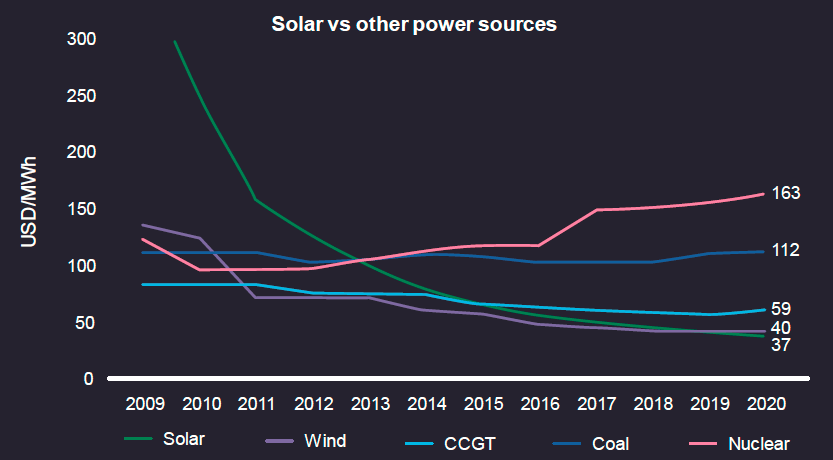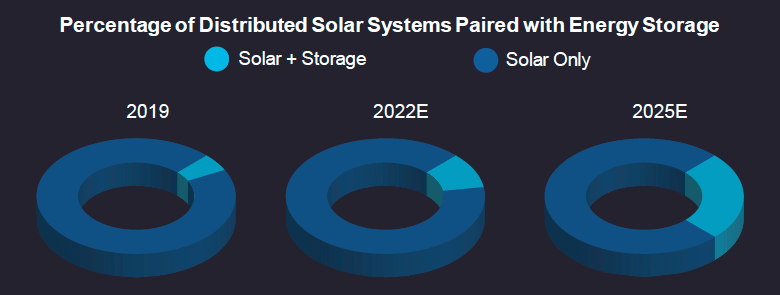Solar power comes across as an easy sustainable energy transition move towards decarbonisation to limit the rise in global temperatures to within 1.5 degrees Celsius. For one, solar is the most abundantly available source of energy. Now, with the prices of solar power reaching competitive levels in certain geographies, there is not a lot that can be argued against its viability.
We have already detailed some metrics that changed this trend briefly during the Covid-19 pandemic in our recent industry insight. Now, the main factor that impacts efficient solar power generation is the availability of sunlight only during daytime and clear skies. However, with the right energy storage solutions, this challenge can be overcome to make solar a comprehensive contributor to an always-on power grid.
But the real test for solar power will be how soon it can become constant with the addition of energy storage and be cost-competitive with fossil fuels used to power electricity generation. How close is solar + storage to compete with conventional electricity sources like coal and gas?
Let’s find out:
Solar growth
Source: IEA; Evalueserve insights; Solarpower Europe
- 138 GW of global solar power capacity added in 2020
- ~50% higher solar capacity expansion in 2020 compared with 2019
- 3% of global electricity generation came from solar in 2019
- 25-30 years is the average life of solar power installations
Source: Lazard; Evalueserve Insights; SEIA
- 92% drop in solar PV module prices from $4.88 per watt in 2000 to $0.38 per watt in 2019.
- 20% reduction in solar panel cost in the last 5 years, with a further decline in price expected to continue.
- $0.03 to $0.06 per KWh is the cost of solar-powered electricity in the U.S.
- $0.05 to $0.17 per KWh is the cost of electricity from fossil fuels in the U.S.
Solar + Storage
Solar coupled with energy storage is pegged to grow substantially in the near term. In the U.S., its share is estimated to rise from under 6% of the total solar at present, to 23.9% by 2025.
Source: SEIA/Wood Mackenzie Power and Renewables; Solarpower Europe
- 21% YoY decrease in the bottom end range of solar + storage’s Levelised Cost of Energy (LCOE)
- 15-22% is the average efficiency rate of solar power generation
- 20-40% is the average efficiency rate of fossil fuels
- U.S., India, Germany, Portugal among other countries have already launched hybrid renewable auctions, wherein co-location of powerplant and energy storage helps provide flexible energy solutions.
Types of Storage for Solar
With solar power already being cost-competitive and even lower in some places than its fossil-fuelled counterparts, it is no surprise that we see its installed capacity expanding between around 18% to 20% annually. And while solar power generation is still less efficient than conventional fuel sources, there is a big push to up the former’s efficiency levels through innovative technology and methods as seen in our earlier industry insight. However, where it falters is its intermittent supply due to seasonal changes, nighttime, and other factors, which can be augmented and stabilized through the addition of co-located energy storage solutions.
The first thing solar + storage addresses are peak-hour demand, which is usually evening or night-time across geographies. The issue with energy storage is that apart from power, various industries including transportation will also feed off of the same grid and might even employ some of the same storage solutions, which could affect the supply of their materials but not permanently. The advantage in the same vein is that owing to the overall need for rapid energy storage development, the costs will come down significantly too.
While there are various energy storage solutions under consideration and development, various battery electricity storage (BES) systems are touted to cost between 50% and 66% lower by 2030. These are the top options currently being worked upon for cost-optimization:
- Lead-acid: Flooded LA, VRLA
- High-temperature: NaS NaNiCI
- Flow: VRFB, ZBFB
- Li-ion: NCA, NMC/LMO, LFP
BES Growth Aspects
- 4.67 TWh in energy storage during 2017 is expected to nearly triple to 11.89-15.72 TWh if the share of renewable energy in the energy system is to be doubled by 2030.
- 17 times the current capacity of battery electricity storage (BES) systems in stationary applications are needed by 2030 to meet the doubling of renewables in the global energy mix by then.
- 50-60% cost reduction various types of BES expected by 2030
- 60-64% of total BES energy capacity in stationary applications by 2030 is expected to be behind-the-meter (on-site) storage, making it the primary use case.
- 11-14% of total BES capacity by 2030 is expected to go towards renewable capacity firming at the utility scale.
- 10-15% of total installed BES capacity is expected to provide use-case for frequency regulation.
Conclusion
As variable renewable energy (VRE), particularly solar, grows it also increases the potential for the rapid growth of energy storage solutions. In addition, storage from other renewables will also push the case for economies of scale in favor of energy storage. This will be further augmented by the rapid development of emerging and proven storage technologies as the world population and industry lean more and more onto electric power for their clean energy needs.
If there is no future without electricity, then it can also be said that there is no future without electricity storage. As we mull this, R&D teams in different corners of the globe are on the verge of breakthroughs towards the cost-effective prices for energy storage, breakthroughs that should continue over the coming decades. With solar touted to take over as a primary source of energy in the near future, the estimations of energy storage needs will know only one direction – UP!
Download the full industry insight here
To discover how you can adapt for tomorrow, contact decarbonization@evalueserve.com .





